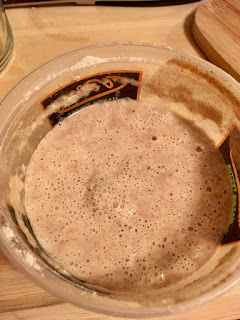The beginning
I've been wanting to figure out how to make sourdough bread for some time now, and have actually started a couple of starters (and eventually failed to keep them alive). I've had very mixed results with sourdough breads in the past, but I'm intrigued by the possibility of using wild yeasts and bacteria (instead of store-bought yeast) to make bread. It's ancient and modern, delicious and nutritious. And in this new stay-at-home time, I figured this was a good time to finally figure it out.
Guided by Tartine Bread (which was recommended by a friend of mine), I built a sourdough starter a couple weeks ago, and was finally ready to put it to the test.
First bread
Here's the starter (a few weeks back). Nice and bubbly, slightly sour, but not too sour.
Mixing the starter into some warm water. One test of an active starter is that it floats on the water. This stuff is barely floating, so I'm not sure it's really ready.
Here's the bread dough a couple hours into its first rise. You can see some bubbles along the side, which is a good sign.
But then something went wrong. I think the problem might be that I forgot about the dough for several hours, then it got late so I put it in the refrigerator overnight. Here it is, the next morning, looking like a delicious pancake that didn't quite make it into the skillet.
I was pretty certain it wasn't going to turn into a beautiful loaf of bread, but I figured I'd bake it anyway. This frisbee was the result.
Dense, tough, and ready to chip a tooth. Almost as good as Grandma Barnhart's famous biscuits.
Second bread
This one turned out a little better. I was able to start it earlier in the day and give it more time to rise. I'm liking the look of it in this basket.
And the final loaf turned out pretty well, though not quite as tall as I hoped. I was thinking it would rise a little higher in the oven, but it was not to be. This loaf had a good, strong sour flavor, which wasn't quite what I was hoping for. So, on to...
Third bread!
I think I've finally arrived, and I'm ready to open a bakery. I think I let this one rise longer than the 2nd loaf, and then I refrigerated it overnight for the final, long rise. Or maybe the starter is finally ready to make good bread. I'm not really sure, and only time will tell if I'll be able to duplicate (or even improve on) this loaf.
The adventure continues...
















Wow! This is a great post. I am inspired by your own sourdough journey.
ReplyDeleteWe also have Steve and Rachel, resident sourdough baking experts, available to potentially consult with...hmmmmmm
That third loaf looks really tasty, though. Great job!
DeleteWow, Ben - I'm impressed. Definitely overproofed on the first one. You could potentially add more flour and water to an overproofed dough and make a double batch after another rise. Or, take up disc golf.
ReplyDeleteI love the crust color and open crumb on the last two. Did you brush your crust with anything? Did you like the cloth bowl or the coil better? Pretty good flavor?
That's good to know about the overproofing. I'll keep that in mind for future batches. The loaves don't get brushed with anything. I do love that color too!
DeleteI think I prefer the coil basket, but that was my first time using the cloth bowl, and I was pleasantly surprised by how well it worked.
The flavor is pretty good, but a little on the chewier side and slightly more sour than I was hoping for. Robertson really advocates for a non-sour sourdough loaf, and I'm wondering if I can produce that with a little more practice.
Your bread is on a positive exponential curve! That third one looks amazing! And what type of bowl/basket did you use to get that ringed look?
ReplyDeleteThanks, Janell! Yeah, the third one is definitely the best loaf I've ever made, and I actually thought it might be another failed loaf before I baked it. I was very pleasantly surprised to take off the lid and find that beauty.
DeleteAwhile back I got a banneton proofing basket (something like this: https://www.amazon.com/Banneton-Proofing-Basket-Proving-Baskets/), which is what produces those rings.